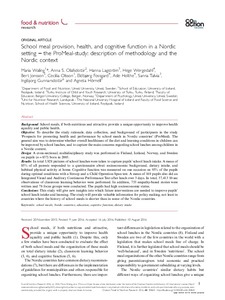School meal provision, health, and cognitive function in a Nordic setting – the ProMeal-study: description of methodology and the Nordic context
Waling M; Olafsdottir AS; Lagström H; Wergedahl H; Jonsson B; Olsson C; Fossgard E; Holthe A; Talvia S; Gunnarsdottir I; Hörnell A
https://urn.fi/URN:NBN:fi-fe2021042715845
Tiivistelmä
BACKGROUND:
School meals, if both nutritious and attractive, provide a unique opportunity to improve health equality and public health.
OBJECTIVE:
To
describe the study rationale, data collection, and background of
participants in the study 'Prospects for promoting health and
performance by school meals in Nordic countries' (ProMeal). The general
aim was to determine whether overall healthiness of the diet and
learning conditions in children can be improved by school lunches, and
to capture the main concerns regarding school lunches among children in a
Nordic context.
DESIGN:
A cross-sectional, multidisciplinary study was performed in Finland, Iceland, Norway, and Sweden on pupils (n=837) born in 2003.
RESULTS:
In
total 3,928 pictures of school lunches were taken to capture pupils'
school lunch intake. A mean of 85% of all parents responded to a
questionnaire about socioeconomic background, dietary intake, and
habitual physical activity at home. Cognitive function was measured on
one occasion on 93% of the pupils during optimal conditions with a
Stroop and a Child Operation Span test. A mean of 169 pupils also did an
Integrated Visual and Auditory Continuous Performance Test after lunch
over 3 days. In total, 37,413 10-sec observations of classroom learning
behavior were performed. In addition, 753 empathy-based stories were
written and 78 focus groups were conducted. The pupils had high
socioeconomic status.
CONCLUSIONS:
This
study will give new insights into which future interventions are needed
to improve pupils' school lunch intake and learning. The study will
provide valuable information for policy making, not least in countries
where the history of school meals is shorter than in some of the Nordic
countries.
Kokoelmat
- Rinnakkaistallenteet [27094]
